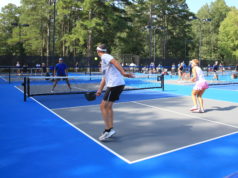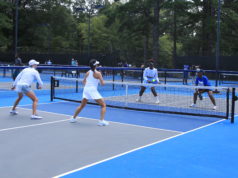NEW RULE ALLOWS TIEBREAK IN LIEU OF THIRD SET
I have heard that ALTA is now allowing a third-set tiebreak to be played rather than a full set if all players on the court agree. Is that correct and do we have to decide before the match begins?
Celia Sheridan, Junior Leagues Vice President
This is a very good question and was just changed in the rules, becoming effective with the 2017 summer season. It applies to all leagues. With the agreement of all players involved, a third set 10-point tiebreak may be played in lieu of a third set to determine a split-set match. For further clarification, this would be an ALTA tiebreak (not Coman) with a team winning if first to 10 by 2 points. The decision to play a tiebreak can be decided at any time during the match as long as all players involved agree. This tiebreak will not be played during playoffs or City Finals without the authority of the ALTA president or league VP. For further understanding, please refer to rules for adult leagues under “Dual Meets.”
A SHAKEUP IN THE LINEUP
Teams have exchanged lineups prior to starting the matches. If it becomes known that one of my players cannot make the default time, what are my options for moving players on the card to avoid a default or getting someone not on the card to come and play?
Jane Milton, Thursday Women’s League Vice President
This scenario happens quite frequently. In the ALTA General Rules Adult League, section IV, D. addresses this issue. Any eligible player can be moved up on a scorecard. Once a player is scratched from a card they cannot play in that dual meet. After cards have been exchanged you can move a player up or off but never down. You can also get an eligible player who was not on the original scorecard to step in and take the place of the person who is not available.
PUT SOME PACE ON IT
My understanding of tennis etiquette is that the server “sets the pace” of the game, meaning that the receiving team (after retrieving any wayward balls on their court and tending to untied laces and the like) should promptly set up to receive the serve and not keep the server waiting. Yet, recently during my service game, the opponents kept turning their backs and having extended strategy conversations (I assume). Finally, on one point, after quite a wait and repeated calls over to them that we were ready to start the point, I simply served up the ball (they were nowhere in the line of fire). This got their attention. They seemed miffed that I objected to them taking as long as they wanted to converse between my service points. Can receivers hold up a server to have a talk? What are the rules?
Joyce Vance, First Vice President
The answer to your question is found in USTA Friend at Court; Rule 21, page 10: When to Serve and Receive: The server shall not serve until the receiver is ready. However, the receiver shall play to the reasonable pace of the server and shall be ready to receive within a reasonable time of the server being ready.
FORGIVE MY REACH
Yesterday, during my doubles match, a drop shot was hit to my side of the court. The shot had a lot of backspin on it and the ball bounced and spun back over the net. Am I able to hit that ball by reaching over the net?
Holly Underwood, Sunday Women’s League Vice President
According to the 2017 Friend at Court, the following rules apply: On page 12, rule 25. b. states: It is a good return if: After the ball in play has hit the ground within the correct court and has spun or been blown back over the net, the player reaches over the net and plays the ball into the correct court, provided that the player does not break rule 24. On page 11, rule 24. g. states: The point is lost if: The player or the racket, whether in the player’s hand or not, or anything which the player is wearing or carrying touches the net, net posts/singles sticks, cord or metal cable, strap or band, or the opponent’s court at any time while the ball is in play. So, yes, you can hit that ball, but you must not touch the net in doing so.
If you’ve ever had a situation occur in a match where no one on the court knew the rule that applied, send your inquiry to Good Question. ALTA officials answer questions in each issue of Net News and yours could be chosen next. Submit your question, along with your name, league, team name and level to altaeditor@altatennis.org.




